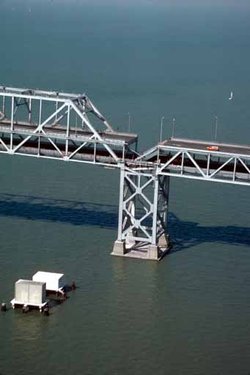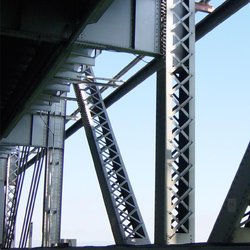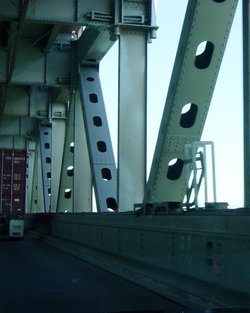San Francisco-Oakland Bay Bridge
|
|
The San Francisco-Oakland Bay Bridge (locally known as the Bay Bridge) spans the San Francisco Bay and links the California cities of Oakland and San Francisco. The bridge consists of two major segments connecting a central island, Yerba Buena Island, with each shore. The western segment terminating in San Francisco consists of two suspension bridges end-to-end with a central anchorage. The eastern span terminating in Oakland consists of a truss causeway, five medium span truss bridges and a double tower cantilever span.
| Contents |
History and construction
The concept of a bridge spanning the San Francisco Bay had been considered since the California gold rush days. Several newspaper articles during the early 1870's discussed the idea. In early 1872 a “Bay Bridge Committee” was hard at work on plans to construct a railroad bridge. The April 1872 issue of the San Francisco Real Estate Circular contained an item about the committee:
The Bay Bridge Committee lately submitted its report to the Board of Supervisors, in which compromise with the Central Pacific was recommended; also the bridging of the bay at Ravenswood and the granting of railroad facilities at Mission Bay and on the water front. Wm. C. Ralston, ex-Mayor Selby and James Otis were on this committee. A daily newspaper attempts to account for the advice of these gentlemen to the city by hinting that they were afraid of the railroad company, and therefore made their recommendations to suit its interests.
The self-proclaimed Emperor Norton saw fit to decree several times that a suspension bridge be constructed to connect Oakland and San Francisco. Later in 1872, frustrated that nothing had happened Norton decreed:
WHEREAS, we issued our decree ordering the citizens of San Francisco and Oakland to appropriate funds for the survey of a suspension bridge from Oakland Point via Goat Island; also for a tunnel; and to ascertain which is the best project; and whereas the said citizens have hitherto neglected to notice our said decree; and whereas we are determined our authority shall be fully respected; now, therefore, we do hereby command the arrest by the army of both the Boards of City Fathers if they persist in neglecting our decrees.
Given under our royal hand and seal at San Francisco, this 17th day of September, 1872.
Unlike most of Emperor Norton's eccentric decrees, this one had wide public and political appeal. Yet, the task seemed too daunting as the bay was deemed too wide and too deep. In 1921, over 40 years after Norton's death, an underwater tube was considered, but it became clear that it would be inadequate for vehicular traffic. Finally, with the increasing popularity and availability of the automobile, support for a transbay crossing grew during the 1920s. In 1926, the California Legislature established the Toll Bridge Authority with the responsibility of bridging San Francisco and Alameda County.
On February 20, 1931, after a great deal of lobbying, California received the go-ahead by the United States Congress to build the Bay Bridge.
SF-Oakland-Bay-Bridge-Construction.jpg
To make the bridge design more feasible, the path was chosen to pass through Yerba Buena Island, significantly reducing the amount of material needed to construct a transbay crossing. The U.S. Army and Navy granted permission to use the island as an anchorage.
The 1.78 mile western span of the bridge between San Francisco and Yerba Buena Island presented an enormous engineering challenge. The bay was up to 100 feet (30 m) deep in places and the soil required new foundation-laying techniques. The solution was to construct a massive man-made concrete anchorage half way between San Francisco and the island and build two complete suspension bridges on either side.
The eastern span was a marvelous engineering feat as well. The crossing from Yerba Buena Island to Oakland was spanned by a 10,176 foot combination of cantilever, long span trusses, and shorter trusses, forming the longest bridge of its kind at the time, with the cantilever portion being the most massive yet constructed.
Connecting the two halves of the bridge is Yerba Buena Tunnel, which was the largest diameter bore tunnel in the world, measuring 76 feet wide, 56 feet high, and 1,700 feet long. The enormous amount of rock and dirt excavated from the tunnel was used in part to create Treasure Island.
Construction began on July 9, 1933 and the bridge was opened to traffic on Thursday, November 12, 1936, at 12:30 p.m. Construction began shortly after that of the Golden Gate Bridge but the Bay Bridge was completed six months sooner. The total cost of construction for the bridge was $79.5 million.
When the bridge first opened, it carried U.S. Highways 40 and 50. This was replaced by Interstate 80 in 1964.[1] (http://www.pcpages.com/sanfrancisco/skyway.htm)
The original west approach ended at Fifth Street; this still exists as the left exit and entrance from the freeway, which now continues as the James Lick Skyway.
Modifications
When the bridge first opened, the upper deck consisted of three lanes of traffic in each direction. The lower deck carried three lanes of truck traffic (with the central lane initially for passing only — a very dangerous configuration) and two streetcar tracks used by the Key Rail System. Automobile traffic increased dramatically in the ensuing decades while the Key Rail System declined and in 1957 the bridge was reconfigured with five lanes of westbound traffic on the upper deck and five lanes of eastbound traffic on the lower deck. Trucks were allowed on both decks and the railway was removed. Owing to a lack of clearance for trucks through the upper deck portion of the Yerba Buena tunnel, it was necessary to lower the upper deck where it passed through the tunnel and to correspondingly excavate the lower portion. This was done while the bridge was in use by using a movable temporary span over the portion being lowered. On the lower deck of the tunnel and its eastern viaduct extension it was necessary to remove central supports, with each transverse beam being doubled to take the load across all lanes. It was also necessary to further reinforce each beam supporting the upper deck throughout the entire span, modifications still visible to the traveler.
Earthquake damage
During the October 17, 1989, Loma Prieta earthquake, which measured 7.1 on the Richter scale, a 50-foot section of the upper deck of the eastern truss portion of the bridge collapsed onto the deck below, indirectly causing one death (actually due to misdirection of traffic by the California Highway Patrol). The bridge was closed for a month and one day as construction crews repaired the fallen section. It reopened on November 18th of that year.
Given the distance to the epicenter of the Loma Prieta (roughly 70 miles south of San Francisco), there was great surprise at the localized destruction around the Bay Area. Analysis points to the likelihood of reflected seismic waves from deep earth crust discontinuities. Failures were mostly located in areas of poor soil conditions due to building over filled-in creeks or on sand and rubble mixes from the 1906 earthquake - all of which were saturated with water and prone to liquefaction. (An exception was the Cypress Viaduct collapse, blamed on poor engineering in certain details, combined with large-structure resonances that had not been considered during design.)
SFOakBBRetrofit.jpg
Western span retrofitting
The western suspension span has also undergone extensive seismic retrofitting, almost all at a detail level that does not substantially affect (and in some cases improves) the overall appearance.
Lattice beam conversion
Most of the beams were originally constructed of two plate I-beams joined with lattices of flat strip or angle stock, depending upon structural requirements. These have all been reconstructed by replacing the lattice stock with continuous steel plate.
Hot rivet replacement
The entire bridge was fabricated using hot steel rivets, which are impossible to heat treat and so remain relatively soft. Analysis showed that these could fail in shear under extreme stress and so at most locations each was removed and replaced with a heat treated high-strength bolt. Additional diagonal bracing has been added underneath each deck and may be seen under the lower deck in one of the illustrations at the right.
Concrete overlays
Analysis showed that some massive concrete supports could burst and crumble under possible stresses. In particular the western supports were extensively modified. First, the location of existing reinforcing bar is determined using magnetic techniques. In areas between bars holes are drilled. Into these holes is inserted an L-shaped bar that protrudes several hundred centimeters. (6 to 10 inches). This bar is retained in the hole with a high strength epoxy adhesive. The entire surface of the structure is thus covered with closely spaced protrusions. To these protrusions, and hooked by them, and wired to them a network of horizontal and vertical reinforcing bar is applied. Mold surface plates are then positioned to retain high strength concrete, which is then pumped into the void. After removal of the forms work the surface appears similar to the original concrete. This technique has been applied elsewhere throughout California to improve freeway overpass abutments and some overpass central supports which have unconventional shapes. (Other techniques such as jacket and grout are applied to simple vertical posts - see the seismic retrofit article.)
Eastern span replacement
EasternSFO_OAKBrFromTI.jpg

| This article or section contains information about a current or ongoing event. |
| Information may change rapidly as the event progresses and may temporarily contain inaccuracies, bias, or vandalism due to a high frequency of edits. |
It was clear that the eastern span must be made earthquake resistant. It had been known for over thirty years that a major local earthquake on either of the two local faults would destroy the major cantilever span. Like most expensive-to-solve potential problems, there was no political will to act. The Loma Prieta earthquake was the proverbial "wakeup call" for all concerned.
The initial proposal for the eastern span involved the construction of substantial concrete pylons to replace or supplement the existing supports. There would also be modifications to the lattice beams as is now complete for the western span. The original cost estimate for this refit was 200 million US. dollars. The overall appearance would be little changed.
Engineering and economic analysis in 1999 suggested that a simple replacement bridge would cost only a few hundred million dollars more than a retrofit of the existing eastern span and that a replacement would have a far longer expected useful life — perhaps 75 to 100 years rather than 30, and would require far less maintenance. Rather than retrofit the existing bridge the authorities decided to replace the entire eastern span with an elevated viaduct described by critics as a "freeway on stilts". This was not received well by either the public or the politicians.
5262004bidopening.jpg
A design contest was held for a "signature span" (a span with distinctive and dramatic appearance, unique to the site). A number of innovative proposals were examined and a winner was selected.
After more than a decade of study, construction began on a replacement for the cantilever portion of the bridge on January 29, 2002, with completion originally slated for 2007.
The authorities were shocked when they opened the bids on the proposed tower portion, as there was only a single bid and it was considerably more expensive. The entire project is now expected to cost $5.1 billion (as of July 2004), up from a 1997 estimate of $1.1 billion (for a simple viaduct) and a March 2003 estimate of $2.6 billion that included a tower span.
On December 10, 2004, the Governor's office announced that the signature span concept has been scrapped, with the completion of the bridge now to be by the construction of the simple viaduct originally proposed. The design, having gone full circle, remains expensive due to the continued high cost of materials.
As of early May, 2005, the controversy continues. In essence, the Governor does not believe that the entire state should share in the costs of building the bridge, as he considers it to be a local (Bay Area) problem. Construction has also been delayed by an investigation into charges by fifteen former welders and inspectors on the new eastern span that welders were rushed to an extent affecting their performance on up to one third of the welds and that workers were ordered to cover up defective welds by re-welding in a superficial manner. Subsequent detailed investigation by three separate independent outside consultants did not support these charges (see the eastern span replacement article for detailed information).
The Emperor Norton's early work at promoting a bridge between San Francisco and Oakland was commemorated on Tuesday, December 14th, 2004, when the San Francisco Board of Supervisors approved a resolution calling for the new eastern span of the bridge to be named after Norton. The resolution was introduced by Supervisor Aaron Peskin (the supervisor currently elected from the district where Norton lived).
Financing
Full_Moon.jpg
When it opened in 1936, the toll was 65 cents, collected in each direction. Within months, it was lowered to 50 cents in order to compete with the ferry system, and finally to 25 cents as this was shown sufficient to pay off the original revenue bonds on schedule. As with other bridges of the era, passage was to be free after completion of the repayment of the original bonds.
In the interest of reducing the cost of collecting tolls and of building additional toll booths, all bridges in the Bay Area were converted to collect tolls in only one direction, with the amount collected doubled.
Tolls were subsequently raised to finance improvements to the bridge approaches, required to connect with new freeways, and to subsidize public transit in order to reduce traffic over the bridge. To cover the cost of the new span and other retrofit and various transit projects in the region, the toll for westbound automobile traffic rose from $1.00 to $2.00 and again in July 2004 to $3.00, along with other state-run bridges. A proposal for a $4.00 toll is expected soon. Eastbound traffic remains toll free.
In fiction and film
- In William Gibson's futuristic Bridge Trilogy of novels, the Bay Bridge, closed to traffic after an earthquake, has been taken over by the homeless and turned into a miniature city of the dispossessed.
- In the movie The Graduate, Dustin Hoffman can be seen driving in traffic over the bridge. To make the scene more photogenic, all the traffic is going the wrong way on the top level of the bridge. The shot was filmed very early on a weekend morning while traffic was stopped to prevent any head-on collisions.
The Bay Bridge at a glance
SFOakBrWestPartVEast.jpg
SFOakBrEastPartVEast.jpg
- Entire span
- Location: Interstate 80 between San Francisco and Alameda Counties.
- Length: 23,000 feet (4.35 miles, 7 kilometers)
- Western Suspension Bridges
- Length 9,260 feet (2,822 meters)
- Vertical clearance 220 feet (67 meters)
- Tower Height 526 feet (160 meters) (from water level)
- Eastern Cantilever Bridge, truss bridges and truss causeway approaches:
- Length: 10,176 feet (3,101 meters)
- Vertical clearance 191 feet (58 meters)
- Deepest Bridge Pier: 242 feet below water level - 396 feet high (120 meters)
- Avg. Daily Traffic: 280,000 vehicles
External links
- California Department of Transportation (CalTrans) official Bay Bridge site (http://www.dot.ca.gov/hq/esc/tollbridge/SFOBB/Sfobb.html)
- CalTrans home page (http://www.caltrans.ca.gov/)
- Oakland Berkeley & Eastern (http://rail.blu-streak.com): Interurbans that used to run on the Bay Bridge.
- Symphonies in Steel: Bay Bridge and the Golden Gate (http://www.sfmuseum.org/hist9/mcgloin.html)
- San Francisco-Oakland Bay Bridge East Span Seismic Safety Project (http://www.dot.ca.gov/dist4/eastspans/index.html)
- A Bridge Too Weak? (http://www.sfweekly.com/issues/2004-03-17/news/feature.html)
- CalTrans Alternatives report December 10, 2004 PDF download (http://www.caltrans.ca.gov/baybridge/MainSpanReportDraftDec10.1230.pdf) (not a web page)
- San Francisco Gate story on renaming the bridge (http://sfgate.com/cgi-bin/article.cgi?file=/c/a/2004/12/15/MNGUMAC6LN1.DTL)




